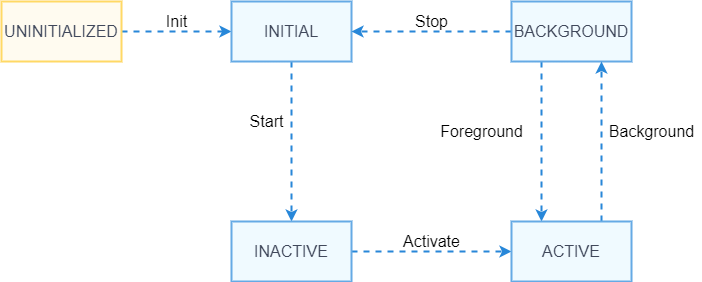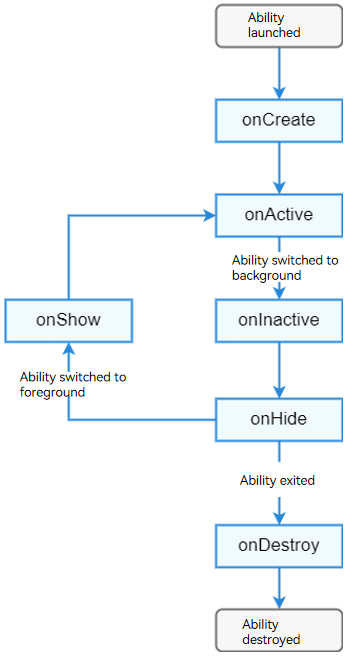PageAbility Lifecycle
The PageAbility lifecycle defines all states of a PageAbility, such as INACTIVE, ACTIVE, and BACKGROUND. The figure below shows the lifecycle state transition.
Figure 1 PageAbility lifecycle

Table 1 PageAbility lifecycle states
| State | Description |
|---|---|
| UNINITIALIZED | The PageAbility is not initialized. This is a temporary state, from which a PageAbility changes directly to the INITIAL state upon its creation. |
| INITIAL | The PageAbility is initialized but not running. The PageAbility enters the INACTIVE state after it is started. |
| INACTIVE | The PageAbility is visible but does not gain focus. |
| ACTIVE | The PageAbility runs in the foreground and has focus. |
| BACKGROUND | The PageAbility runs in the background. After being re-activated, the PageAbility enters the ACTIVE state. After being destroyed, it enters the INITIAL state. |
You can override the lifecycle callbacks (as described in the table below) in app.js or app.ets.
Table 2 PageAbility lifecycle callbacks
| API | Description |
|---|---|
| onCreate() | Called when the ability is created for the first time. You can initialize the application in this callback. |
| onDestroy() | Called when the ability is destroyed. In this callback, you can make preparations for application exit, such as recycling resources and clearing the cache. |
| onActive() | Called when the ability is switched to the foreground and gains focus. |
| onInactive() | Called when the ability loses focus. An ability loses focus when it is about to enter the background state. |
| onShow() | Called when the ability is switched from the background to the foreground. In this case, the ability is visible to users. |
| onHide() | Called when the ability is switched from the foreground to the background. In this case, the ability is invisible to users. |
The following figure shows the relationship between lifecycle callbacks and lifecycle states of the PageAbility.
Figure 2 Relationship between lifecycle callbacks and lifecycle states

NOTE
- The PageAbility lifecycle callbacks are synchronous.
- The app.js file provides only the onCreate and onDestroy callbacks, and the app.ets file provides the full lifecycle callbacks.